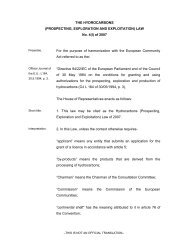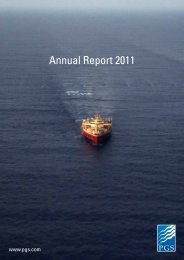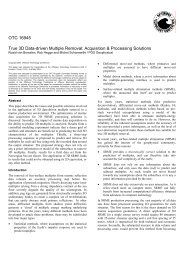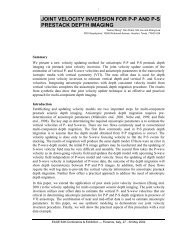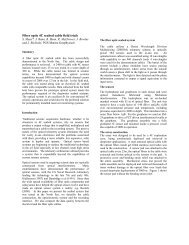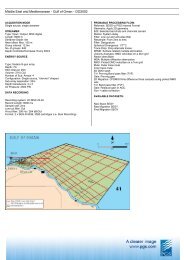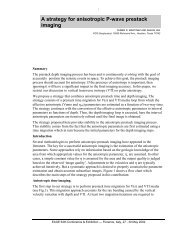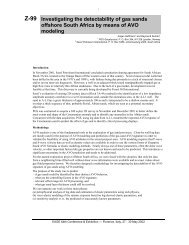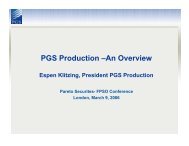Z-99 High-resolution transforms and amplitude preservation - PGS
Z-99 High-resolution transforms and amplitude preservation - PGS
Z-99 High-resolution transforms and amplitude preservation - PGS
You also want an ePaper? Increase the reach of your titles
YUMPU automatically turns print PDFs into web optimized ePapers that Google loves.
1<br />
Z-<strong>99</strong> <strong>High</strong>-<strong>resolution</strong> <strong>transforms</strong> <strong>and</strong> <strong>amplitude</strong><br />
<strong>preservation</strong><br />
Michel Schonewille 1 <strong>and</strong> Paul Zwartjes 2<br />
1<br />
<strong>PGS</strong> Geophysical, <strong>PGS</strong> Court, Halfway Green, Walton-on-Thames, Surrey KT12 1RS, UK;<br />
2<br />
Delft University of Technology, Delft, the Netherl<strong>and</strong>s<br />
Abstract<br />
<strong>High</strong>-<strong>resolution</strong> <strong>transforms</strong> have several advantages over st<strong>and</strong>ard least squares <strong>transforms</strong>. However, the high<strong>resolution</strong><br />
transform can show extra artifacts, which may compromise <strong>amplitude</strong> <strong>preservation</strong>. In addition,<br />
<strong>amplitude</strong>s may be affected if the induced sparseness is too strong. In this paper the <strong>amplitude</strong> <strong>preservation</strong> of<br />
high-<strong>resolution</strong> <strong>transforms</strong> is studied using synthetic data. Firstly, the high-<strong>resolution</strong> parabolic Radon transform<br />
is shown to improve both the <strong>preservation</strong> of primary AVO <strong>and</strong> demultiple efficiency related to st<strong>and</strong>ard least<br />
squares methods. Secondly it is shown that a high <strong>resolution</strong> Fourier/Radon regularization provides an improved<br />
interpolation of data with large gaps, <strong>and</strong> less edge effects. Finally, it is shown that that the artifacts can be<br />
suppressed by using a frequency independent sparseness prior. This prior can be derived in a cost efficient<br />
manner from a previous (adjacent) common midpoint gather.<br />
Introduction<br />
The high <strong>resolution</strong> transform proposed by Sacchi <strong>and</strong> Ulrych (1<strong>99</strong>5) uses a sparseness prior for the curvature<br />
direction, which gives it several advantages compared with st<strong>and</strong>ard least squares <strong>transforms</strong>. For the parabolic<br />
Radon transform (Hampson, 1986), it improves the separation of primaries <strong>and</strong> multiples that have a small<br />
move-out difference (Hunt, 1<strong>99</strong>6). <strong>High</strong> <strong>resolution</strong> Fourier regularization shows a better reconstruction in large<br />
gaps than st<strong>and</strong>ard least squares Fourier regularization (Zwartjes <strong>and</strong> Duijndam, 2000). However, the high<strong>resolution</strong><br />
transform can cause smearing of energy in the transform domain in the direction in which no<br />
sparseness is imposed, i.e. the time direction (see e.g. Sacchi <strong>and</strong> Ulrych, 1<strong>99</strong>5 Fig. 4a; Hargreaves <strong>and</strong> Cooper<br />
2001, Fig. 2). This smearing raises the question of <strong>amplitude</strong> <strong>preservation</strong>. In addition, <strong>amplitude</strong> <strong>preservation</strong><br />
may not be optimal if the induced sparseness would be too strong. For example, if a perfectly parabolic event<br />
with AVO variation is focused onto a single curvature parameter, then the AVO variation is lost. In this paper,<br />
the <strong>amplitude</strong> <strong>preservation</strong> (especially important for AVO analysis <strong>and</strong> time-lapse seismic) of high-<strong>resolution</strong><br />
<strong>transforms</strong> is studied using a number of synthetic examples.<br />
<strong>High</strong> <strong>resolution</strong> Radon transform <strong>and</strong> AVO<br />
Fig. 1a shows a simple synthetic data set that was used to test the high-<strong>resolution</strong> parabolic Radon transform.<br />
The events are perfectly parabolic, but the curvatures are not exactly equal to the curvature parameters that are<br />
used for the Radon transform (the primaries also have small curvature). Moreover, most primaries <strong>and</strong> multiples<br />
have varying <strong>amplitude</strong>s with offset. In Fig. 1b, the same data with primaries only are shown. Fig. 1c shows the<br />
result after demultiple using the least squares transform. For a comparison with the high <strong>resolution</strong> transform, we<br />
will look at the difference between the gather after demultiple (Fig. 1c) <strong>and</strong> the modeled multiple free gather (Fig<br />
1b). In Fig. 1d this difference (1c-1b) is shown for the least squares transform, <strong>and</strong> in Fig. 1g for the high<strong>resolution</strong><br />
transform (the displays show clipped data, note the gray-scale bars next to the plots). The high<strong>resolution</strong><br />
transform shows a better multiple elimination (there is less energy in the plot), but also some smearing<br />
(or ringing) of energy in the time direction (e.g. between 0 <strong>and</strong> 0.8 second in Fig. 1g). The Radon spectra are<br />
shown in Fig. 1e <strong>and</strong> 1h respectively. The <strong>amplitude</strong> <strong>preservation</strong> is illustrated in Fig. 1f for a constant <strong>amplitude</strong><br />
primary. The solid line is the ideal modeled AVO variation, the dashed line the <strong>amplitude</strong> after least squares<br />
EAGE 64th Conference & Exhibition — Florence, Italy, 27 - 30 May 2002
Radon demultiple, <strong>and</strong> the dotted line the <strong>amplitude</strong> after high-<strong>resolution</strong> Radon demultiple. In Fig. 1i a similar<br />
plot is shown for a primary with AVO variation. Both results indicate that better <strong>amplitude</strong> <strong>preservation</strong> is<br />
obtained using high-<strong>resolution</strong> Radon demultiple.<br />
2<br />
<strong>High</strong> <strong>resolution</strong> Radon transform with constant weighting<br />
The smearing of energy in the time direction as shown in Fig. 1g can effectively be suppressed by using a<br />
frequency independent sparseness prior (assuming no dispersion). This sparseness prior is the average over a<br />
frequency range of the sparseness priors derived using the frequency dependent transform (Sacchi <strong>and</strong> Ulrych,<br />
1<strong>99</strong>5). The frequency range should be chosen where the data have a good signal to noise ratio <strong>and</strong> are unaliased.<br />
Preferably it is chosen at frequencies that show good <strong>resolution</strong> in the curvature parameters, i.e. not the lower<br />
frequencies. In Figs. 1j to 1l the absolute Radon spectra are shown for the different methods using a logarithmic<br />
scale to show the artifacts. From left to right the st<strong>and</strong>ard least squares transform (1j), the high <strong>resolution</strong><br />
transform (1k) <strong>and</strong> the high <strong>resolution</strong> transform with frequency independent prior (1l) are shown. The smearing<br />
of energy in the time direction present in Fig. 1k is not visible in Fig. 1l. In practice, the frequency independent<br />
prior can be derived in a cost efficient manner from a previous (adjacent) common midpoint gather.<br />
Fourier/Radon regularization of time-lapse data<br />
In Figure 2 an example is shown of the application of Fourier/Radon regularization to two synthetic data sets<br />
(“base” <strong>and</strong> “monitor”) with the same subsurface model but different sampling (simulating a time-lapse<br />
repeatability test). The acquisition parameters are: 8 streamers, with 75m separation <strong>and</strong> 240 channels, group<br />
interval 12.5m <strong>and</strong> shot interval of 18.75m (flip-flop). The data are regularized using a two-step approach (see<br />
Duijndam et al., 1<strong>99</strong>9). First the data are regularized along streamers such that the inline midpoints are exactly at<br />
cross-lines. Then the data is sorted to cross-lines, <strong>and</strong> the irregularly sampled cross-line midpoint <strong>and</strong> offset<br />
coordinates are regularized using a combined Fourier/parabolic Radon transform (Fourier for the midpoint<br />
coordinate). The sampling in the equivalent cross-line, for the base- <strong>and</strong> monitor survey is shown in Fig. 2b <strong>and</strong><br />
2c. The base <strong>and</strong> monitor data have been regularized, <strong>and</strong> the normalized RMS difference is shown in Fig. 2d for<br />
the least squares transform, <strong>and</strong> in Fig. 2e for the high-<strong>resolution</strong> transform. The normalized RMS has been<br />
computed in a time window of 1.5s-2.5s, which included a reflection from a layer which is dipping 13 degrees in<br />
the cross-line direction. The three main conclusions that can be drawn from these results are that the high<strong>resolution</strong><br />
transform provides much improved reconstruction in the gap, reduced edge effects, <strong>and</strong> a comparable<br />
(if not slightly better) repeatability at the well sampled parts. Note that good time-lapse repeatability does not<br />
directly mean that <strong>amplitude</strong> <strong>preservation</strong> is good, since base <strong>and</strong> monitor data may have been affected in the<br />
same way. However, it has been verified (but not shown here) that the <strong>amplitude</strong> <strong>preservation</strong> is also good in the<br />
case of AVO variations <strong>and</strong> <strong>amplitude</strong> variations in the midpoint direction.<br />
Discussion <strong>and</strong> conclusions<br />
On these synthetic data sets, the high <strong>resolution</strong> <strong>transforms</strong> show significantly reduced edge effects <strong>and</strong> much<br />
better reconstruction in large gaps than st<strong>and</strong>ard least squares <strong>transforms</strong>. The smearing in the time direction<br />
observed with the high <strong>resolution</strong> <strong>transforms</strong> can be effectively suppressed by using the proposed method with a<br />
frequency independent sparseness prior. The good <strong>amplitude</strong> <strong>preservation</strong> means that the high-<strong>resolution</strong><br />
<strong>transforms</strong> are well suited for demultiple before AVO analysis, <strong>and</strong> for regularization of time-lapse data. Finally,<br />
it is remarked that the difference in performance between the high-<strong>resolution</strong> <strong>transforms</strong> <strong>and</strong> the st<strong>and</strong>ard least<br />
squares <strong>transforms</strong> may be smaller for field data, due to noise <strong>and</strong> a higher number of curvatures present.<br />
References<br />
Duijndam, A., Koek, A., Ongkiehong, L., Romijn, R. <strong>and</strong> Schonewille, M., 1<strong>99</strong>9, A general reconstruction scheme for<br />
dominant azimuth 3-D seismic data, 69th Ann. Internat. Mtg: Soc. of Expl. Geophys., 1441-1444. Hampson, D., 1986,<br />
Inverse velocity stacking for multiple elimination, J. Can. Soc. Expl. Geophys., 22(1):44-55.<br />
Hargreaves, N. <strong>and</strong> Cooper, N., 2001, <strong>High</strong>-<strong>resolution</strong> radon demultiple, 71st Ann. Internat. Mtg: Soc. of Expl. Geophys.,<br />
1325-1328.<br />
Hunt, L., Cary, P. <strong>and</strong> Upham, W., 1<strong>99</strong>6, The impact of an improved Radon transform on multiple attenuation, 66th Ann.<br />
Internat. Mtg: Soc. of Expl. Geophys., 1535-1538.<br />
Sacchi, M.D., <strong>and</strong> Ulrych, T.J., 1<strong>99</strong>5, <strong>High</strong>-<strong>resolution</strong> velocity gathers <strong>and</strong> offset space reconstruction, Geophysics, 60, 4,<br />
1169-1117.<br />
Zwartjes, P. <strong>and</strong> Duijndam, A., 2000, Optimizing reconstruction for sparse spatial sampling, 70th Ann. Internat. Mtg: Soc. of<br />
Expl. Geophys., 2162-2165.
3<br />
0<br />
[a]<br />
1.5<br />
0<br />
[b]<br />
1.5<br />
0<br />
[c ]<br />
1.5<br />
1<br />
1<br />
0.5<br />
1<br />
1<br />
0.5<br />
1<br />
1<br />
0.5<br />
time [s]<br />
2<br />
3<br />
0<br />
time [s]<br />
2<br />
-0.5<br />
3<br />
-1<br />
0<br />
time [s]<br />
2<br />
-0.5<br />
3<br />
-1<br />
0<br />
-0.5<br />
-1<br />
1 2 3<br />
o ffset [km]<br />
-1.5<br />
1 2 3<br />
offset [km]<br />
-1.5<br />
1 2<br />
offset [km]<br />
3<br />
-1.5<br />
0<br />
[d]<br />
0<br />
[e]<br />
0.6<br />
1.1<br />
[f]<br />
time [s]<br />
1<br />
2<br />
3<br />
0.02<br />
1<br />
0.01<br />
0<br />
time [s]<br />
-0.01<br />
-0.02<br />
2<br />
3<br />
0.4<br />
1.05<br />
0.2<br />
0 1<br />
-0.2<br />
0.95<br />
-0.4<br />
1 2 3<br />
o ffset [km]<br />
-0.03<br />
0 0.2 0.4 0.6<br />
curvature<br />
0.9<br />
1 2<br />
o ffset [km]<br />
3<br />
time [s]<br />
0<br />
1<br />
2<br />
3<br />
[g]<br />
0<br />
0.02<br />
1<br />
0.01<br />
0<br />
time [s]<br />
-0.01<br />
-0.02<br />
2<br />
3<br />
[h]<br />
0.6<br />
1.15<br />
0.4<br />
1.1<br />
0.2<br />
1.05<br />
0<br />
1<br />
-0.2<br />
-0.40.95<br />
[i]<br />
1 2 3<br />
o ffset [km]<br />
-0.03<br />
0 0.2 0.4 0.6<br />
curvature<br />
0.9<br />
0.2 0.4 0.6 0.8<br />
o ffset [km]<br />
1<br />
0<br />
[j]<br />
0<br />
0<br />
[k]<br />
0<br />
0<br />
[l]<br />
0<br />
1<br />
-10<br />
1<br />
-10<br />
1<br />
-10<br />
time [s]<br />
2<br />
-20<br />
time [s]<br />
2<br />
-20<br />
time [s]<br />
2<br />
-20<br />
3<br />
-30<br />
3<br />
-30<br />
3<br />
-30<br />
0 0.2 0.4 0.6<br />
curvature<br />
-40<br />
0 0.2 0.4 0.6<br />
curvature<br />
-40<br />
0 0.2 0.4<br />
curvature<br />
0.6<br />
-40<br />
Figure 1: Comparing conventional <strong>and</strong> high <strong>resolution</strong> parabolic Radon demultiple: (a) input data gather;<br />
(b) primaries only; (c) data after multiple elimination with conventional Radon demultiple; (d) difference<br />
between modelled primaries <strong>and</strong> data after conventional Radon demultiple; (e) Radon domain for<br />
conventional transform; (f) <strong>amplitude</strong> of first primary: solid line - modelled AVO variation; dashed line -<br />
conventional Radon; dotted line - high <strong>resolution</strong> Radon; (g) similar plot as Fig. 1d, but now for the high<br />
<strong>resolution</strong> transform; (h) Radon domain for the high <strong>resolution</strong> transform; (i) <strong>amplitude</strong> of second primary:<br />
solid line - modelled AVO variation; dashed line - conventional Radon; dotted line - high <strong>resolution</strong> Radon;<br />
(j) logarithmic plot of absolute Radon spectrum for the conventional transform; (k) logarithmic plot of<br />
absolute Radon spectrum for the high <strong>resolution</strong> transform; (l) logarithmic plot of absolute Radon spectrum<br />
for the high <strong>resolution</strong> transform with frequency independent prior.<br />
EAGE 64th Conference & Exhibition — Florence, Italy, 27 - 30 May 2002
4<br />
[a]<br />
[b]<br />
[c]<br />
[d]<br />
[e]<br />
Figure 2: Comparing conventional <strong>and</strong> high <strong>resolution</strong> Fourier/Radon regularization for a synthetic time-lapse<br />
data set: (a) Subsurface model; (b) sampling in cross-line midpoint, offset for the base data (no feathering); (c)<br />
sampling for monitor data set; (d) RMS difference between the regularized base <strong>and</strong> monitor data between 1.5s<br />
<strong>and</strong> 2.5s, using the conventional least squares Fourier/parabolic Radon regularization; (e) RMS difference for the<br />
high <strong>resolution</strong> Fourier/Radon regularization.<br />
Acknowledgements<br />
We would like to thank <strong>PGS</strong> geophysical for the permission to publish this paper.



